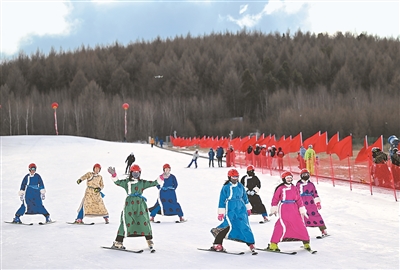




- BRNN
- BRI News
- BRNN News
- Database
Official Documents Polices and Regulations
Inter-government Documents International Cooperation BRI Countries
Business Guide Economic Data BRI Data
Trade
Investment Projects Latest projects
Cases - Content Pool

Ski enthusiasts enjoy skiing at a resort in Arxan city, north China's Inner Mongolia Autonomous Region. (Xinhua/Bei He)
The ice and snow season is underway in China. According to guidelines recently issued by the General Office of the State Council, the scale of China's snow and ice economy is projected to reach 1.2 trillion yuan ($165 billion) by 2027 and 1.5 trillion yuan by 2030.
The guidelines propose measures to advance ice and snow sports, enhance the industrial chain, improve infrastructure and support services, and stimulate consumption related to these activities.
"The ice and snow economy includes the manufacturing of sports equipment, services for ice and snow tourism, and the promotion of ice and snow culture," said Wang Xueli, a professor at Tsinghua University. Wang emphasized that developing the entire industrial chain can transform the ice and snow economy into a new growth driver.
Statistics indicate that the number of people participating in ice and snow leisure tourism during the 2024-2025 winter season is expected to exceed 500 million, a significant increase from 385 million last winter.
The ninth Asian Winter Games will take place in Harbin, Heilongjiang Province, in February 2025, providing another opportunity to boost the city's ice and snow tourism.
In the 2023-2024 snow season, Harbin welcomed more than 87 million tourists, a 300 percent increase year on year. During this period, the city generated tourism revenue of 125 billion yuan, a remarkable 500-percent rise.

A child poses for a photo in front of a sculpture themed on the ninth Asian Winter Games Harbin 2025 in Harbin, northeast China's Heilongjiang Province. (Xinhua/Xie Jianfei)
In addition to promoting the high-quality development of ice and snow sports equipment manufacturing, the guidelines recommend nurturing snow and ice businesses, building well-known brands and industry leaders, and supporting small- and medium-sized enterprises that utilize specialized technologies to produce unique products.
According to Hao Lishun, an official with the Ministry of Industry and Information Technology, China offers 15 major categories of ice and snow equipment designed to meet the needs of individuals, business venues, competitive events, and mass sports. Hao noted that the number of ice and snow equipment enterprises in the country has increased from approximately 300 in 2015 to around 900 in 2023.
The evolution of ice and snow sports equipment manufacturing reflects the broader growth of the ice and snow industry. In recent years, Chinese companies have made significant strides in research and development and the production of ice and snow sports equipment, effectively breaking foreign monopolies. The World Winter Sports (Beijing) Expo 2024, held earlier this year in Beijing, showcased various equipment, including domestically produced snowmakers, snow motorcycles, and snowshoes, highlighting the high-quality development of China's ice and snow sports sector.
Many ski resorts have recently opened their doors to visitors.
The Beidahu Ski Resort in Jilin Province has installed 100 new snowmakers and expanded its ski tracks from 64 to 74, increasing hotel accommodations to 9,000 beds. Meanwhile, the Keketuohai International Ski Resort in Altay Prefecture, located in northwest China's Xinjiang Uygur Autonomous Region, welcomes between 1,500 and 2,000 tourists daily.
The guidelines also recommend enhancing consumption related to snow and ice sports, diversifying consumer products in this sector, improving the consumption environment, and refining the standards system.
Wang noted that many ski resorts are now offering integrated snow and ice tourism packages, which combine skiing and resort services. These resorts are focused on improving service quality and elevating the overall consumer experience.

Tel:86-10-65363107, 86-10-65368220, 86-10-65363106